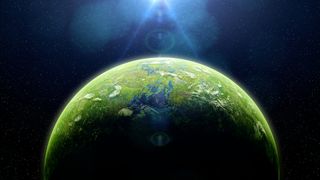
What's the best evidence we've found for alien life?
Don't expect an alien invasion anytime soon.

We've all wondered whether we're alone in the universe, and with potentially habitable planets, strange space signals and UFO hearings hitting the headlines, it's starting to feel like we're on the cusp of a major extraterrestrial discovery. But what's the best scientific evidence we've found for the existence of alien life?
The sobering reality is that there isn't any yet. There's no scientific evidence for aliens in the declassified UFO videos, in mutilated cows whose injuries are blamed on extraterrestrial activities or in purported alien bodies. Nor is there any such evidence in the formal academic research. Live Science checked in with experts to make sure.
"There's just no evidence right now," Professor Sara Seager, an astrophysicist and planetary scientist at the Massachusetts Institute of Technology and author of "The Smallest Lights in the Universe: A Memoir" (Crown, 2020), told Live Science.
Nikku Madhusudhan, a professor of astrophysics and exoplanetary science at the University of Cambridge, gave a similar response, saying, "I don't think we have clear evidence just yet of any kind for alien life."
There is, however, good reason to hold out hope that the evidence will eventually come, even if it isn't personally delivered by a little green man.
Related: What would colors look like on other planets?
Madhusudhan told Live Science that "there are hints here and there" and "there is evidence for habitable conditions." In other words, there are signs that certain planets and moons could harbor life, but we haven't found evidence of life in these places yet.
There may be hundreds of millions of habitable planets in our galaxy alone. Scientists consider planets capable of hosting life if they sit in the so-called habitable zone, the distance from a star where it's possible for a rocky planet to have liquid water on the surface, an essential ingredient for life on Earth. Planets and moons outside of the habitable zone aren't necessarily inhospitable to life either. For example, Jupiter's moon Europa isn't in the sun's habitable zone, but has a saltwater ocean beneath its icy crust that may be able to host life.
Researchers are looking inside and outside of our solar system for signs of life. Madhusudhan led a study, published in October 2023 in The Astrophysical Journal Letters, that detected hints of an ocean on a planet called K2-18 b, located more than 100 light-years away. Their data also suggested "potential signs" of dimethyl sulfide, a chemical that, as far as we know, is produced only by life on Earth.
"That is very tentative," he said. "We don't know if it is present or not, but we do see it in the data at some level."
That potential sign of alien life will be subject to further studies and may be refuted. Regardless, Madhusudhan said he wouldn't be surprised if we found evidence for extraterrestrial microbial life within the next decade. "I'd be very surprised if there is no life out there of any kind," he added.
Seager believes we'd confirm the existence of alien life only with sample-return missions — collecting samples from another planet or moon and bringing them back to Earth for study, in-situ measurements or "incredibly futuristic" technology, like a solar gravitational lens telescope, a theoretical instrument that would use the sun's gravity to magnify light from distant planets.
"With all the tools we have now, or that we could build with enough money, it's sample return, because I don't see anything else being definitive," Seager said.
Seager was part of a 2020 study published in the journal Nature Astronomy that reported the "apparent presence" of phosphine gas — a potential signature of life — on Venus. The research has been debated in the scientific community since.
Researchers will argue about whether potential life signatures detected on other planets are real, and then whether those signatures are accurate, and then whether those signatures are actually caused by life, which they currently won't be able to prove without collecting samples, according to Seager.
However, she's confident that scientists will find more signs of water and oceans that could indicate habitability, as well as gases that might be due to life. "I think that's enough to keep this generation's long search moving forward," she said.
Keep in mind that space is incredibly vast. It would take humans more than a million years to visit K2-18 b with traditional rocket propulsion. Even sending our fastest probe to the nearest known exoplanet, Proxima Centauri b, would take thousands of years. The planets and moons within our solar system are right on our doorstep by comparison, with probe travel times ranging from some years to mere months.
Sign up for the Live Science daily newsletter now
Get the world’s most fascinating discoveries delivered straight to your inbox.

Patrick Pester is a freelance writer and previously a staff writer at Live Science. His background is in wildlife conservation and he has worked with endangered species around the world. Patrick holds a master's degree in international journalism from Cardiff University in the U.K.
Most Popular

By Deepa Jain

By Tom Metcalfe

By Deepa Jain